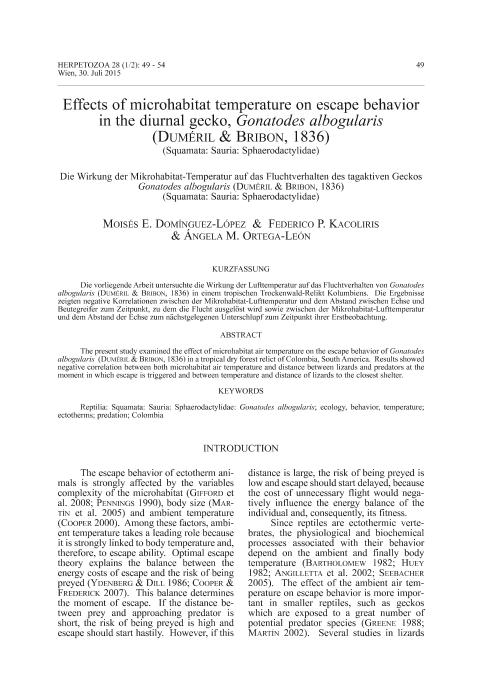Artículo
The present study examined the effect of microhabitat air temperature on the escape behavior of Gonatodes albogularis (Duéril & bribon, 1836) in a tropical dry forest relict of Colombia, south america. results showed negative correlation between both microhabitat air temperature and distance between lizards and predators at the moment in which escape is triggered and between temperature and distance of lizards to the closest shelter. Die vorliegende arbeit untersuchte die wirkung der lufttemperatur auf das fluchtverhalten von Gonatodes albogularis (duMéril & bribon, 1836) in einem tropischen Trockenwald-relikt kolumbiens. die ergebnisse zeigten negative korrelationen zwischen der Mikrohabitat-lufttemperatur und dem abstand zwischen echse und beutegreifer zum Zeitpunkt, zu dem die flucht ausgelöst wird sowie zwischen der Mikrohabitat-lufttemperatur und dem abstand der echse zum nächstgelegenen unterschlupf zum Zeitpunkt ihrer erstbeobachtung.
Effects of microhabitat temperature on escape behavior in the diurnal gecko, Gonatodes albogularis (Duméril & bribon, 1836) (Squamata: Sauria: Sphaerodactylidae)
Título:
Die wirkung der Mikrohabitat-Temperatur auf das fluchtverhalten des tagaktiven Geckos Gonatodes albogularis (duMéril & bribon, 1836) (Squamata: Sauria: Sphaerodactylidae)
Fecha de publicación:
04/2015
Editorial:
Austrian Herpetological Society
Revista:
Herpetozoa
ISSN:
1013-4425
Idioma:
Inglés
Tipo de recurso:
Artículo publicado
Clasificación temática:
Resumen
Palabras clave:
Gonatodes albogularis
,
Ecology
,
Behavior
,
Temperature
,
Ectotherms
,
Predation
,
Colombia
Archivos asociados
Licencia
Identificadores
Colecciones
Articulos(CCT - LA PLATA)
Articulos de CTRO.CIENTIFICO TECNOL.CONICET - LA PLATA
Articulos de CTRO.CIENTIFICO TECNOL.CONICET - LA PLATA
Citación
Domínguez López, Moisés Elias; Kacoliris, Federico Pablo; Ortega León, Angela M.; Effects of microhabitat temperature on escape behavior in the diurnal gecko, Gonatodes albogularis (Duméril & bribon, 1836) (Squamata: Sauria: Sphaerodactylidae); Austrian Herpetological Society; Herpetozoa; 28; 4-2015; 49-54
Compartir




